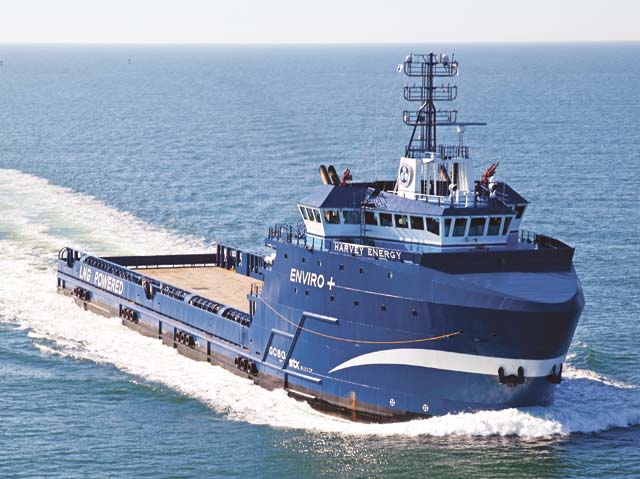Industry insiders watched with interest last week as Harvey Gulf International Marine Inc. filed for Chapter 11 bankruptcy protection (see Kirk Moore’s March 9 WorkBoat.com article). They have been watching the New Orleans-based offshore service vessel operator with intense interest the last few years as it pursued an ambitious and — to some eyes — risky newbuilding program in the face of an extended industry downturn.
Not only was Harvey Gulf building big, beautiful, expensive OSVs like the Harvey Sub-Sea and Harvey Deep-Sea, it built the Gulf of Mexico’s first LNG-powered OSV, the Harvey Energy — overcoming many expensive technological hurdles in the process. And, due to the paucity of LNG bunkering facilities in the U.S. Gulf, the company built an LNG bunkering facility at its Port Fourchon, La., dock.
But decisions have consequences, and the cash-flow shortage Harvey Gulf now faces could have been — and was — foreseen. The corporate strategy may well prove wise in the long run, and Chapter 11 is, after all, merely a negotiating strategy, albeit a shillelagh of one. In this case, Harvey Gulf is using adverse market conditions to renegotiate its contracts.
Do the creditors get to second-guess the company’s decision to build these vessels in these perilous times? No. Do the creditors get to enforce the terms of their original contracts? No. But being sophisticated industry players, they knew that Chapter 11, the bête noir of lenders and creditors, was certainly a possibility.
In fact, they may be appreciating the irony — if not the humor — inherent in Harvey Gulf’s court filing: it describes the steps the company took to defend its position amid “considerable vessel oversupply in the marketplace.” Clearly, those steps didn’t include a retrenchment of a newbuilding program that has added to that oversupply. In fact, in considering the company’s position versus its creditors, the bankruptcy judge might ask Harvey Gulf what steps it did take to cover itself and its creditors in case things turned out as they have.
I wrote in my last blog that the future is probably rosy for the Gulf of Mexico oilfield. But the future is not here yet, and depressed oil prices are continuing past the predictions of many experts. But prognosticators would do well to remember that every time consumer demand picks up, production picks up, and when production picks up, demand for oil picks up. Today’s bumptious economy could be a leading indicator, and then Harvey Gulf would be well positioned to lead the pack.
If so, its creditors may, willingly or not, be along for the ride: Harvey Gulf is seeking to convert a significant portion of its debt into company equity, which is like a farmer who owes the bank for his farm machinery giving the bank a thresher. This was certainly not what the creditors expected or wanted. But regardless of the moral question involved in imposing unbargained-for conditions on pre-existing contracts between industry players, Chapter 11 is the law of the land.
If Harvey Gulf can finally repay all of its suppliers and creditors to their full satisfaction — which company president Shane Guidry assures will happen — this may be one of the situations for which Chapter 11 was crafted.



.JPG.small.400x400.jpg)

